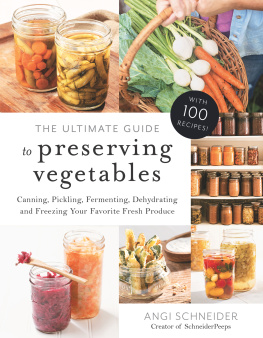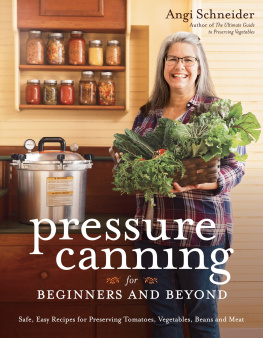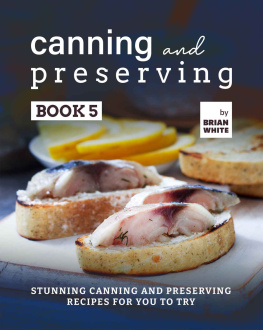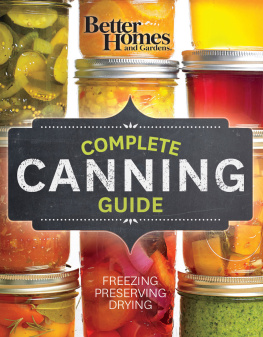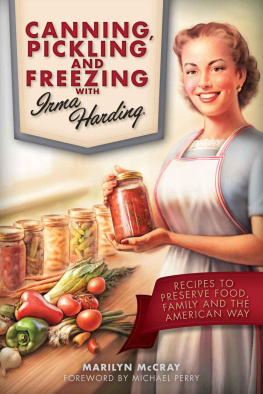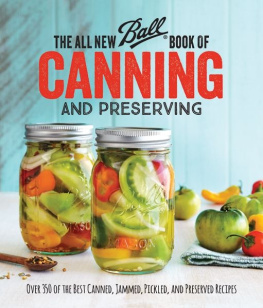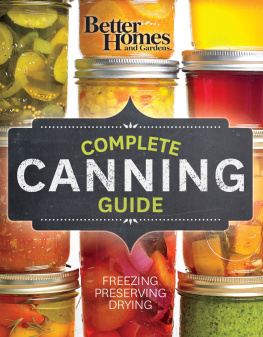THE ULTIMATE GUIDE
to preserving vegetables
Canning, Pickling, Fermenting, Dehydrating and Freezing Your Favorite Fresh Produce
ANGI SCHNEIDER
Creator of SchneiderPeeps

The author and publisher have provided this e-book to you for your personal use only. You may not make this e-book publicly available in any way. Copyright infringement is against the law. If you believe the copy of this e-book you are reading infringes on the authors copyright, please notify the publisher at: http://us.macmillanusa.com/piracy.
This book is dedicated to my husband and children, whom I collectively call my people.
Yall are truly the best people a girl could ask for, and my heart swells with gratitude when I think of all the taste testing, errand running, dish washing, floor sweeping and encouraging you have done to give me time and space to put my words onto paper. Thank you!
Along with clothing, shelter and water, food is essential to life. Its only been in recent history that people have been able to rely on someone else to grow and preserve food for them and not have to worry about doing it themselves.
Many see this as a huge advancement in society, but it comes with high costs to our health, our finances and the environment. As consumers, we demand low prices and beautiful produce; any fruit or vegetable with a blemish is discarded and, when food prices rise, we complain about those who grow our food. In order to fulfill the consumer demands of blemish-free, cheap food, farmers are forced into monocropping and using many pesticides and herbicides in order to get the largest, most perfect harvest per acre.
There is certainly no simple solution to this quandary weve gotten ourselves into. But I firmly believe that each of us can be part of the solution by growing some of our own food, purchasing food from local farmers and preserving food. When we do grow and preserve our own food, our health, our finances and our environment benefit.
Growing up, I knew only one person who grew and preserved her own food, and that was my paternal grandmother, Granny. I have fond memories of us gathered in her kitchen eating homemade biscuits slathered with homemade jam. She would let the older grandchildren go into the backroom and pick a jam or two off the shelves. Then shed pop off the lid, or remove the wax, and serve jams in delicious flavors you could not find in grocery stores.
The backroom was a fascinating place, filled with jars of food Granny had put up and baskets of garden produce, like onions and potatoes, that would keep for a while. While the backroom was fascinating, I never dreamed I would one day have my own backroom filled with food I put up for my family. And yet here I am with a similar backroom in my home.
It all started innocently enough, when my husband found a wild blackberry patch soon after we were married. He excitedly brought home some berries and said we should make jam. So, I did what any newly married woman would do: I called Granny to ask for her super-secret way of turning blackberries into jam. I was so excited!
And this is what she said, Buy a box of Sure-Jell and follow the instructions.
What?! No super-secret recipe? Surely, she must be mistaken. So, I asked if there was another way.
She replied, Yes, dump a bunch of sugar in with the berries and boil them til it gels, but Sure-Jell is faster.
Honestly, I was a little disappointed in the answer. All this time I thought putting up food was hard and confusing and only certain people had the skills to do it. But its not. Im so thankful to Granny for not making a big deal out of canning blackberry jam. Her matter-of-fact answer gave me confidence; she knew canning wasnt hard and that I was capable of canning jam, simply because I could read and follow directions. Truly, you can learn anything if you can read and follow directions.
Expanding the Pantry
Little did I know, 28 years ago, that wild blackberry jam would be the beginning of a journey toward simple living and a DIY lifestyle. I bought the most current edition of the Ball Blue Book Guide to Preserving, and I was inspired. With the right equipment and instructions, I could preserve all kinds of fruits and vegetables!
At about that time, we also started growing a small garden, and I began to realize how much more cheaply we could feed our growing family by gardening and preserving the harvest. This motivated me to learn how to use every edible part of the plant and to expand my idea of a pantry from just dry goods and shelf-stable canned goods to include frozen and fermented foods.
I want to encourage you to think about your pantry as more than just the place you store dry goods: its all the food you have available. Your pantry is unique to your family, and the things you stock it with will also be unique.
You might want to put up 100 quarts (100 L) of canned green beans to ensure you have green beans during the long winter, when the garden is under several feet of snow. Or, if you live in a climate where you can garden all year, like I do, you might want to put up only 30 quarts (30 L) of canned green beans, just to fill in any gaps for when the garden isnt producing much. Or maybe your family doesnt like canned green beans, so you choose to preserve them by freezing them instead of canning them. There is no one way for every family.
The goal of preserving food isnt to have a backroom full of jars of food. The goal of preserving food is to feed your family. Its super important that we take our familys likes and dislikes into consideration and preserve food in such a way that they will eat it.
. As the only pickle lover in my family, I often get a bit jealous when I see other food preservers who have shelf after shelf full of various pickles. I could make all kinds of pickles to fill my shelves, but that would be a waste of food and time, because my family wont eat them, and I cant eat that many.
Preserving food isnt a competition. Its not about who has the fullest shelves or the prettiest preserves. All that matters is that your family eats what you put up.
Reducing Waste
One way to reduce waste and save money is by using all the edible parts of a plant. Im always amazed when people choose to toss out or compost perfectly edible scraps. Ive found that when I use all the edible parts of a plant, I can harvest more and grow less than if I use just the primary edible part.
Many vegetables have edible leaves that we harvest from the garden while were waiting for the main crop to develop. Broccoli and cauliflower leaves taste just like the flower head and are a nice treat in the early fall or spring. I like to preserve carrot and radish tops by making pesto for the freezer. Dont overlook the usefulness of the leaves.

